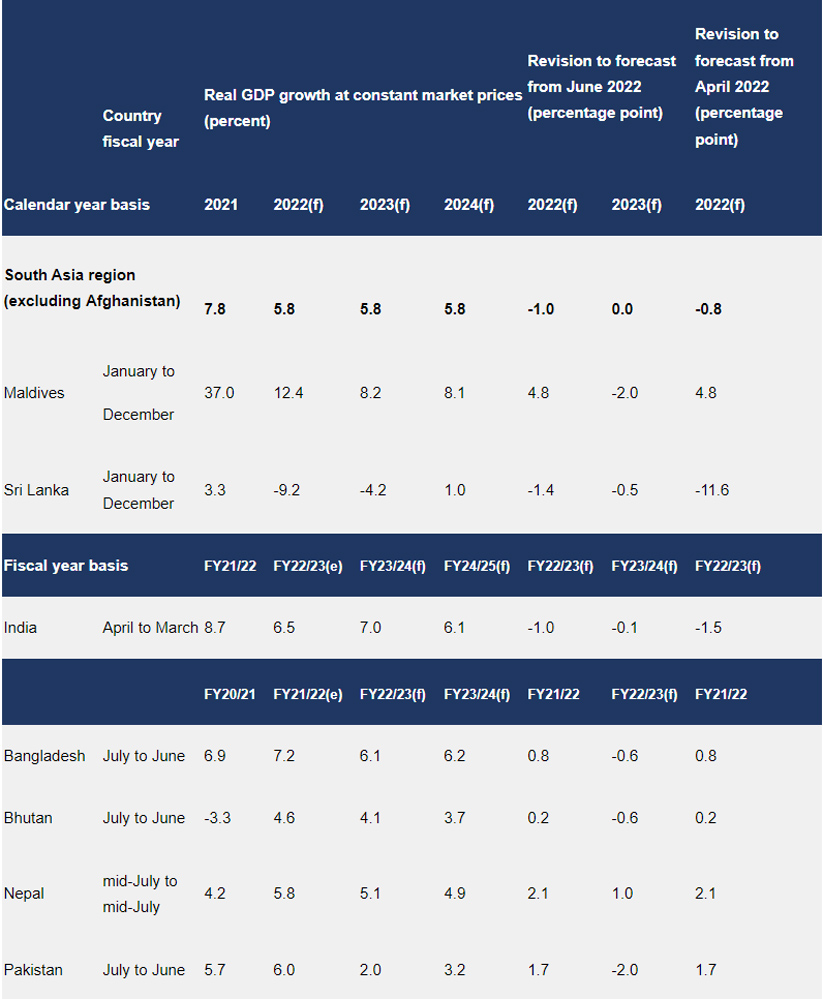Unprecedented shocks rattle South Asia, dampening growth
Inflation in South Asia, caused by elevated global food and energy prices and trade restrictions that worsened food insecurity in the region, is expected to rise to 9.2 percent this year before gradually subsiding. The resulting squeeze on real income is severe, particularly for the region’s poor who spend a large share of their income on food.

Beset with Sri Lanka’s economic crisis, Pakistan’s catastrophic floods, a global slowdown, and impacts of the war in Ukraine, South Asia faces an unprecedented combination of shocks on top of the lingering scars of the COVID-19 pandemic. Growth in the region is dampening, says the World Bank in its twice-a-year update, underscoring the need for countries to build resilience.
Released September 6, the latest South Asia Economic Focus, Coping with Shocks: Migration and the Road to Resilience, projects regional growth to average 5.8 percent this year - a downward revision of 1 percentage point from the forecast made in June. This follows growth of 7.8 percent in 2021, when most countries were rebounding from the pandemic slump.

While economic distress is weighing down all South Asian countries, some are coping better than others. Exports and the services sector in India, the region’s largest economy, have recovered more strongly than the world average while its ample foreign reserves served as a buffer to external shocks. The return of tourism is helping to drive growth in Maldives, and to a lesser extent in Nepal—both of which have dynamic services sectors.
The combined effects of COVID-19 and the record-high commodity prices due to the war in Ukraine took a heavier toll on Sri Lanka, exacerbating its debt woes and depleting foreign reserves. Plunged into its worst-ever economic crisis, Sri Lanka’s real GDP is expected to fall by 9.2 percent this year and a further 4.2 percent in 2023. High commodity prices also worsened Pakistan’s external imbalances, bringing down its reserves. After devastating climate-change-fueled floods submerged one-third of the country this year, its outlook remains subject to significant uncertainty.
“Pandemics, sudden swings in global liquidity and commodity prices, and extreme weather disasters were once tail-end risks. But all three have arrived in rapid succession over the past two years and are testing South Asia’s economies,” said Martin Raiser, World Bank Vice President for South Asia. “In the face of these shocks, countries need to build stronger fiscal and monetary buffers, and reorient scarce resources towards strengthening resilience to protect their people.”
Inflation in South Asia, caused by elevated global food and energy prices and trade restrictions that worsened food insecurity in the region, is expected to rise to 9.2 percent this year before gradually subsiding. The resulting squeeze on real income is severe, particularly for the region’s poor who spend a large share of their income on food.
South Asia’s migrant workers, many of whom are employed in the informal sector, were disproportionately affected when restrictions to movement were imposed during COVID-19. However, the later phase of the pandemic has highlighted the crucial role migration can play in facilitating recovery. Survey data from the report suggests that in late 2021 and early 2022, migration flows are associated with movement from areas hit hard by the pandemic to those that were not, thus helping equilibrate demand and supply of labor in the aftermath of the COVID-19 shock.
“Labor mobility across and within countries enables economic development by allowing people to move to locations where they are more productive. It also helps adjust to shocks such as climate events to which South Asia’s rural poor are particularly vulnerable,” said Hans Timmer, World Bank Chief Economist for South Asia. “Removing restrictions to labor mobility is vital to the region’s resilience and its long-term development.”
To this end, the report offers two recommendations. Firstly, cutting the costs migrants face should be high on the policy agenda. Secondly, policymakers can de-risk migration through several means including more flexible visa policies, mechanisms to support migrant workers during shocks, and social protection programs.
The World Bank’s development updates for Maldives, Nepal, Pakistan, and Sri Lanka were also simultaneously released September 6.








Post a Comment